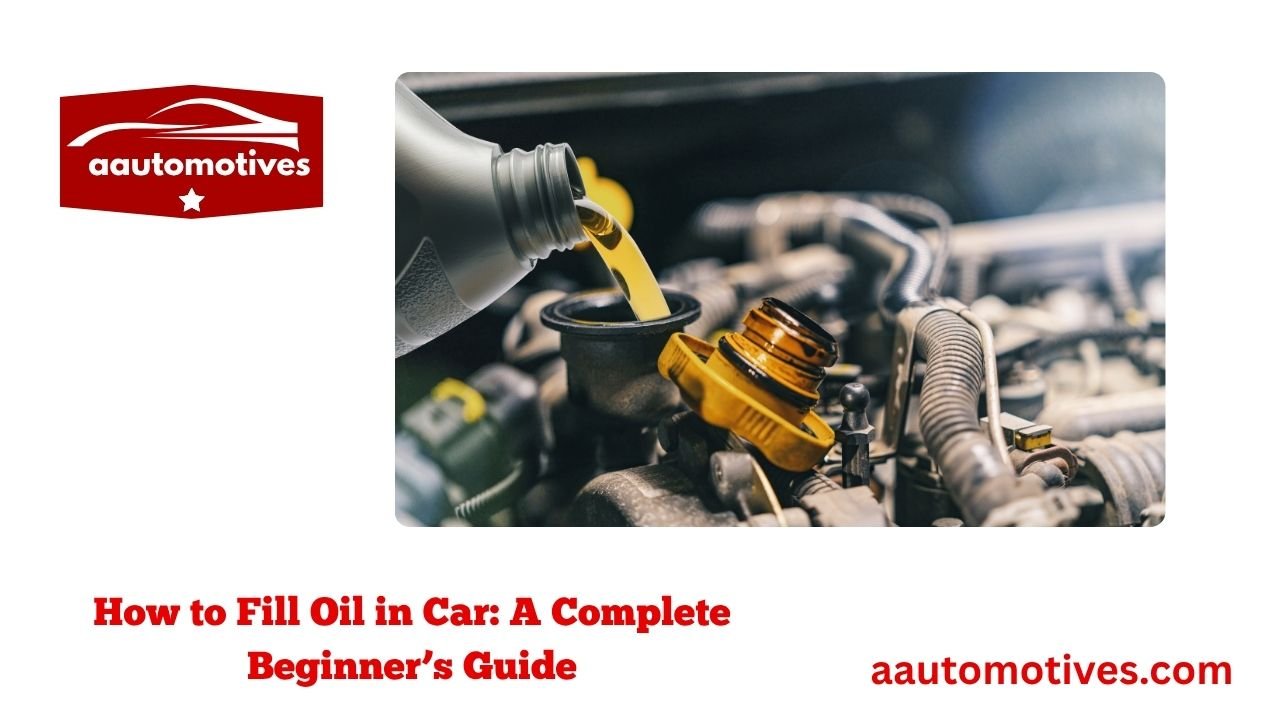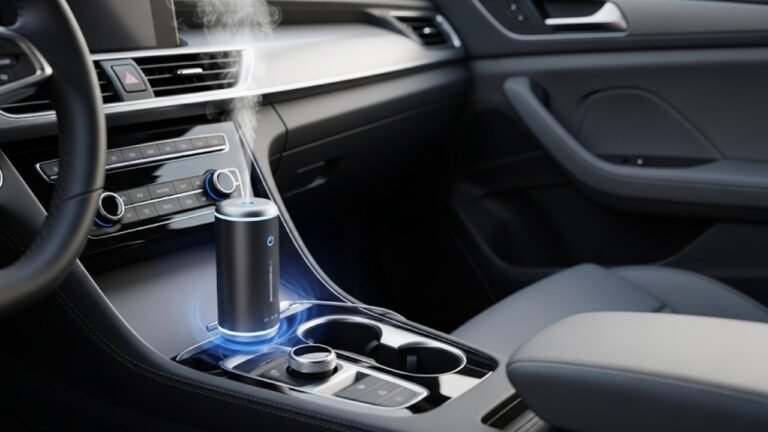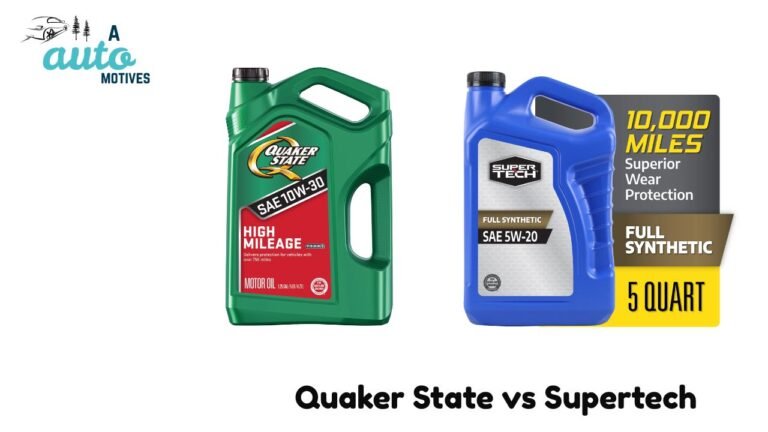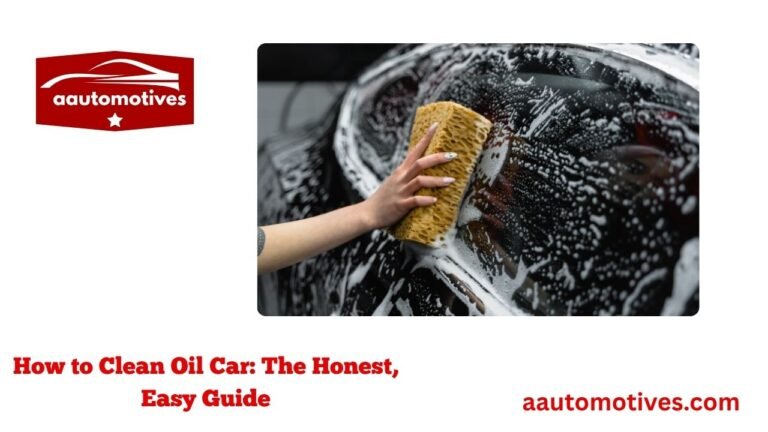How to Fill Oil in Car: A Complete Beginner’s Guide

Have you ever opened your car’s hood and felt like you were staring at a spaceship? You’re not alone. For many people, car maintenance feels like an alien task. But here’s the truth — learning how to fill oil in car isn’t rocket science. It’s one of the most basic and important things you can do to keep your engine healthy.
Just like your body needs water to function, your car needs oil to run smoothly. If your engine oil runs low, the metal parts inside your engine start grinding. It’s like jogging in a desert without water — painful and damaging. Neglecting oil can lead to engine failure, expensive repairs, or even a breakdown in the middle of nowhere.
This guide will walk you through everything step-by-step in a friendly, easy way. Whether you drive a shiny new sedan or a trusty old hatchback, this guide is for you. And yes, there’ll be personal stories, metaphors, cultural tidbits, and all the juicy stuff to make this more than just another boring “how-to.”
In This Article
- 1 Chapter 1: What Engine Oil Actually Does
- 2 Chapter 2: Signs That You Need to Fill Oil in Your Car
- 3 Chapter 3: What You’ll Need Before You Start
- 4 Chapter 4: Step-by-Step — How to Fill Oil in Car
- 5 Chapter 5: Common Mistakes People Make (And How to Avoid Them)
- 6 Chapter 6: How Often Should You Fill Oil in Car?
- 7 Chapter 7: What Type of Oil Should You Use?
- 8 Chapter 8: Cultural Nuances Around Car Maintenance
- 9 Chapter 9: Difference Between Filling and Changing Oil
- 10 Chapter 10: What Happens If You Don’t Fill Engine Oil?
- 11 Chapter 11: How to Store and Dispose of Engine Oil
- 12 Chapter 12: Real-Life Experiences From Drivers Like You
- 13 Chapter 13: The Emotional Connection — Trusting Your Car
- 14 Chapter 14: Bonus Tips to Keep Your Engine Oil Healthy
- 15 Conclusion: A Small Step That Saves Big
Chapter 1: What Engine Oil Actually Does

Here’s what it does:
-
Lubricates engine parts to reduce friction.
-
Cools down the engine and prevents overheating.
-
Cleans dirt, metal particles, and carbon from engine parts.
-
Protects the engine against rust and corrosion.
When the oil level is low or the oil is dirty, none of these functions work well. That’s when problems start creeping in.
A few months back, I ignored that blinking oil light on my dashboard. I thought, “Eh, I’ll get to it later.” Big mistake. My car started making weird ticking noises, like a metronome going offbeat. I had to pay 15,000 BDT (around $140) to fix it — just because I didn’t take 10 minutes to top up the oil.
So moral of the story? Never ignore your oil.
Chapter 2: Signs That You Need to Fill Oil in Your Car
Just like your stomach growls when you’re hungry, your car sends signals when it’s thirsty for oil.
Here are the most common signs:
-
Oil warning light on dashboard
-
Ticking or knocking sounds from the engine
-
Burning oil smell
-
Dark, dirty oil on the dipstick
-
Engine overheating
-
Reduced fuel efficiency
When these signs appear, it’s time to check your oil and, if needed, add more.
Let me tell you a quick story. My cousin drives a Toyota Axio. One day, while heading to Cox’s Bazar, his car started losing power mid-highway. The culprit? Low oil level. We had to pull over at a small local garage and fill it up right there. He had no idea about how to fill oil in car, and that delay cost him three extra hours on the road. Don’t be like him — be prepared.
Chapter 3: What You’ll Need Before You Start
You don’t need to be a mechanic. Just have these items ready:
| Item | Purpose |
|---|---|
| Engine oil (check your owner’s manual) | The lifeblood of your engine |
| Clean funnel | Helps avoid spilling oil everywhere |
| Lint-free rag or paper towel | To wipe the dipstick clean |
| Gloves (optional) | To keep your hands clean |
| Flashlight (optional) | If working in a dark area |
| Owner’s manual | To find the correct oil type and capacity |
Having these ready will save time and make the job smooth.
Chapter 4: Step-by-Step — How to Fill Oil in Car
Let’s now get into the core of this guide — how to fill oil in car. Take a deep breath, grab your tools, and let’s go.
Step 1: Park and Cool Down
First, make sure your car is on level ground and the engine is off. Wait at least 10-15 minutes after driving so the oil settles and the engine cools.
Step 2: Open the Hood
Use the hood latch inside the car (usually near the driver’s seat). Then release the secondary latch under the hood and prop it up securely.
Step 3: Locate the Dipstick and Oil Cap
The dipstick usually has a yellow or orange ring. The oil filler cap often says “OIL” or has an oil can icon.
Step 4: Check the Oil Level
Pull out the dipstick. Wipe it clean with a cloth. Insert it back fully, wait a few seconds, and pull it out again. You’ll see two marks: MIN and MAX.
If the level is below the MIN line, it’s time to add oil.
Step 5: Pour the Oil
Remove the oil filler cap. Place your funnel in the hole. Slowly pour oil in — start with a little, like half a liter. You can always add more, but you can’t take it back once overfilled.
Wait a few minutes. Then recheck the dipstick. If it’s still low, add more — bit by bit. Repeat until the level is close to MAX but not over.
Step 6: Wipe, Close, and Start the Engine
Wipe any spilled oil. Put the dipstick and oil cap back. Close the hood securely. Start the engine and let it run for a minute. Then shut it off and check again.
If the oil level stays steady and there are no warning lights, you’ve done it!
Chapter 5: Common Mistakes People Make (And How to Avoid Them)
Even though filling oil sounds simple, many people make small mistakes. And small mistakes can cause big trouble.
Here’s a list of things to avoid:
-
Overfilling the oil: It can cause foaming and pressure build-up.
-
Using the wrong oil type: Always follow what your manual says — not your friend who drives a totally different car.
-
Forgetting to close the cap: Oil can splash out and create a mess or fire hazard.
-
Not checking oil regularly: Once a month is a good habit.
Tip: Set a monthly reminder on your phone to check your oil. It only takes 5 minutes.
Chapter 6: How Often Should You Fill Oil in Car?
Now that you know how to fill oil in car, you might be wondering how often to do it.
This depends on:
-
Your car’s age
-
Your driving habits
-
Oil type (synthetic vs regular)
-
Engine condition
On average:
-
New cars need an oil top-up every 5,000 to 7,500 km
-
Older cars might need it more frequently, especially if they burn oil
If you drive in Dhaka’s jam-packed traffic or over dusty rural roads, check more often. Hard conditions mean your engine works harder — and burns more oil.
Chapter 7: What Type of Oil Should You Use?
Choosing the right oil is like choosing the right medicine. If you use the wrong one, you won’t get better — you might get worse.
Your owner’s manual will tell you what grade to use (e.g., 5W-30, 10W-40). That code tells you about the viscosity — or thickness — of the oil.
Here’s a quick comparison:
| Oil Grade | Climate | Best For |
|---|---|---|
| 5W-30 | Cold & moderate | Fuel efficiency |
| 10W-40 | Hot climates | Older engines |
| 0W-20 | Very cold | Newer cars |
Chapter 8: Cultural Nuances Around Car Maintenance
In many cultures — especially in South Asia — car maintenance is still considered a “guy thing” or something only the mechanic should handle. But that’s changing.
I remember when my younger sister wanted to go on a solo road trip from Dhaka to Bandarban. Our father insisted that she learn how to fill oil in car before leaving. “Car নষ্ট হইলে, রাস্তার মাঝখানে কই যাইবা?” he said. She learned, practiced in our garage, and didn’t face a single problem on that long hilly ride.
The point is, this knowledge isn’t gendered. It’s empowerment. Whether you’re a university student or a parent doing school runs, knowing how to check and refill oil makes you more independent — and safer.
Chapter 9: Difference Between Filling and Changing Oil
Let’s clear a big confusion: Filling oil and changing oil are not the same.
Here’s a quick comparison table:
| Task | What It Means | When to Do |
|---|---|---|
| Filling oil | Adding oil when the level is low | Anytime you check and find it below the mark |
| Changing oil | Draining out old oil and replacing it entirely | Every 5,000–10,000 km, depending on your oil type and car |
Filling is a quick fix. But changing oil keeps your engine healthy in the long run. You still need full oil changes even if you top it up regularly.
Chapter 10: What Happens If You Don’t Fill Engine Oil?
Neglecting to fill your engine oil is like ignoring a slow leak in a lifeboat — disaster is just a matter of time.
Here’s what can happen:
-
Engine overheating
-
Increased friction inside the engine
-
Reduced engine life
-
Burnt engine parts
-
Complete engine seizure
Imagine driving up the Chittagong Hill Tracts, and your car suddenly stops mid-slope because the engine gave up. The tow truck will come, sure — after 6 hours and a big repair bill. All because you didn’t know how or when to fill oil in your car.
Chapter 11: How to Store and Dispose of Engine Oil
Once you’ve topped up your oil, you might still have some left. Don’t toss it anywhere.
Storage tips:
-
Keep leftover oil in its original container.
-
Store it upright, tightly sealed, and away from sunlight or kids.
-
Write the purchase date on the bottle.
Disposal tips:
-
Never pour used or excess oil down the drain, soil, or river.
-
Take it to a recycling center or ask a local workshop to handle it.
Some auto shops will accept used oil even if you didn’t buy from them. Just ask politely.
Chapter 12: Real-Life Experiences From Drivers Like You
Let’s hear some real stories from regular drivers who learned how to fill oil in car the hard way (or the smart way):
-
Sajjad from Sylhet: “My Honda Civic started vibrating during gear shifts. Turned out the oil was so low it wasn’t lubricating the transmission properly. Filled it up — magic! Smooth again.”
-
Rumi from Rajshahi: “I drive my parents around. One day I noticed a burning smell. Opened the hood and realized I had overfilled the oil. Had to drain it out and refill carefully.”
-
Nasrin from Khulna: “I watched a 5-minute YouTube video and learned how to fill oil in my car. Felt proud the next time the dashboard light blinked. No more panic.”
You see? Learning this skill pays off. It’s not just technical — it’s confidence-building.
Chapter 13: The Emotional Connection — Trusting Your Car
Cars aren’t just machines. For many of us, they’re companions. They take us to work, to loved ones, on vacations, through rainstorms and sunshine.
Learning how to fill oil in car isn’t just about metal and mechanics. It’s about respecting this trusted machine that silently makes your life easier. A well-maintained car speaks to you. It drives smoother, stays quiet, and gives you peace of mind.
And there’s something therapeutic about doing it yourself. That feeling of lifting the hood, checking the dipstick, and knowing you’ve taken care of your car — it builds trust.
Chapter 14: Bonus Tips to Keep Your Engine Oil Healthy
To wrap it up, here are some golden tips to keep your engine oil and car in top shape:
-
Warm up your engine before long drives to circulate oil properly.
-
Don’t rev a cold engine — oil takes time to flow fully.
-
Avoid short trips only — oil works best when the engine is hot.
-
Use additives only if recommended by your mechanic.
-
Stick to service intervals — don’t delay scheduled oil changes.
Conclusion: A Small Step That Saves Big
So now you know — how to fill oil in car is simple, empowering, and essential. It’s a skill every driver should learn, just like knowing how to check tire pressure or change a flat.
This 10-minute act can save you thousands in repair costs. More than that, it gives you confidence and control. You’ll no longer be at the mercy of a blinking dashboard light or a greedy mechanic.
So the next time you pop your hood, don’t hesitate. Be calm, be curious, and trust yourself. Your car — and your future road trips — will thank you for it.






